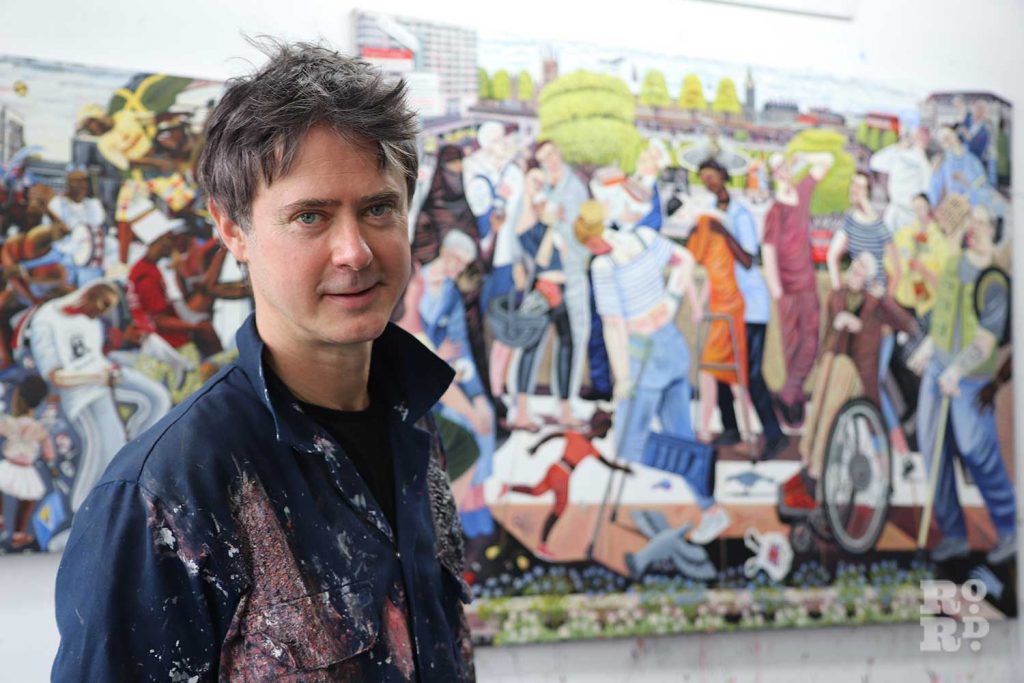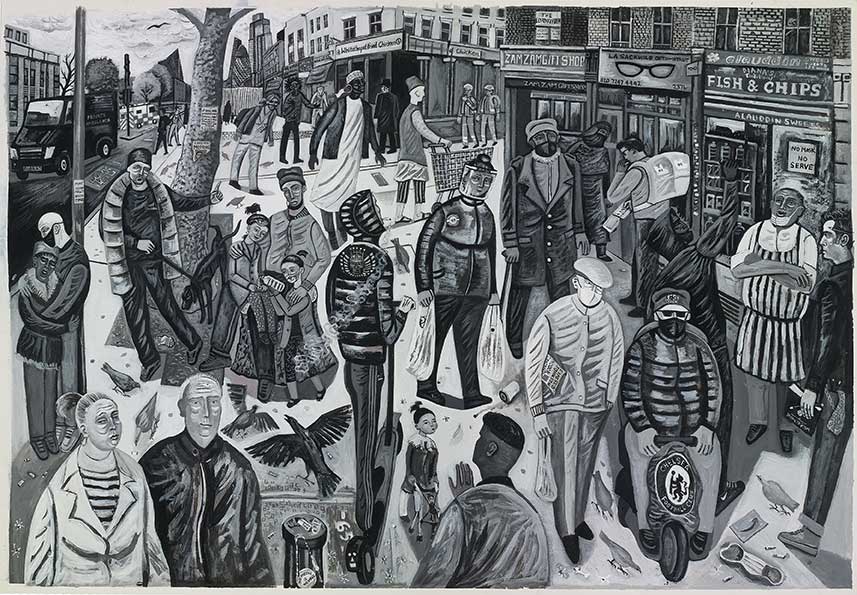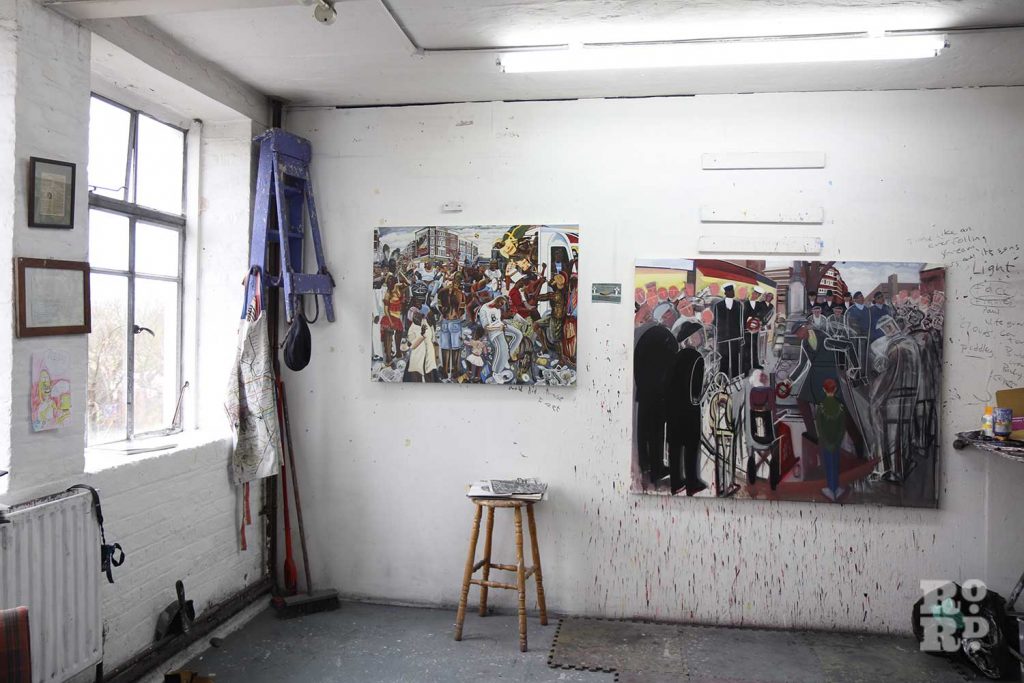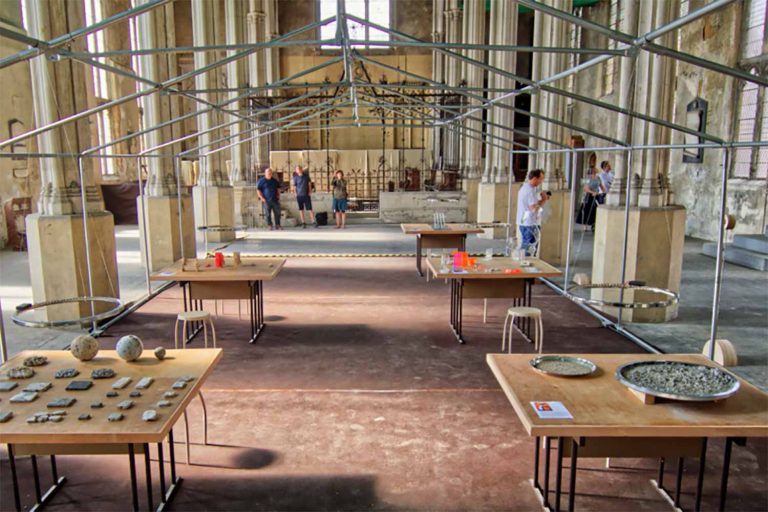Artist Ed Gray: painting a tapestry of the East End
From drug dealers in Mile End Park to army cadets and estate agents, Ed Gray’s urban paintings celebrate the grit and the glitz of the East End and all its characters.
Painting still lifes on window ledges in his younger years, artist Ed Gray quickly realised he was more interested in the people beyond the pane than the arrangements in front of it.
Even on a drizzly February morning, his spacious Mile End studio is imbued with light, spreading over vast unfinished canvasses that lie stacked against the walls and painting materials piled up on tall shelves.
Moving to Acme studios in Mile End in 2008, many of Gray’s expansive, colourful canvasses take inspiration from the local area, featuring scenes outside his window in Mile End Park, to Whitechapel Market and York Hall boxing ring.
His paintings celebrate the good and the bad of urban life, preserving the moments and layers of history that are so easily buried and forgotten in the fast-paced flow of the city.
‘There’s a dark and light that you see in a city and that’s what I’m interested in trying to fit on a canvas,’ says Gray: ‘Maybe not on every canvas, but I suppose I’m trying to build up this tapestry of my vision of a city over 25 years. It comes from the stories of the people and the energy that I see.’

Gazing out of the window onto Mile End Park, Gray observes: ‘You tend to be most inspired by the places you’re most familiar with … I moved here at a time when so much was changing in the East End and that change is still ongoing.
‘There’s so much history here, it’s a point of embarkation where people have been arriving and leaving for generations. You really get a sense of all the lives that have lived here.’
Shortly after he arrived in Mile End, Gray says he was working on another painting but kept on getting distracted by all the different people walking past outside the window.
‘At the time there was Matts Gallery right next door so you had the art crowd, then you had kids playing outside from the Ragged School Museum dressed in Victorian clothes which looked kind of weird,’ he laughs.

‘Then at night, you might have a bit of drug dealing going on, and then there’s Canary Wharf in the distance … So in this one little street, you’ve got all these different things happening.
‘The history of Mile End Park has largely been eroded and forgotten because the city moves so quickly … so I’m really interested in capturing all the layers of history and different stories that this area has.’
Gray’s exuberant impressions of Mile End Park by day and by night reveal the diverse relationships that people have with our local built environment.
From labourers working on the street’s hot tarmac to basketball players, lovers, fishermen and thieves, it’s the East End characters and their everyday interactions that inhabit Gray’s urban theatres.
‘There’s a sense of worshipping the city,’ says Gray: ‘but I’m not interested in only worshipping the positives I’m worshipping the negatives as well.’

His painting of Mile End Underground Station, titled ‘Adoration in the East: Hellfire and Damnation’ depicts the multiplicity of urban life, at once adored and damned.
From Gary the newspaper seller sitting outside the station whatever the weather, to an army cadet from the cadet school just across Mile End Road, the scene celebrates the diverse range of people coming to the East End every day.
A bearded hipster inhabits the canvas’ bottom right-hand corner, and Gray himself features in the painting asleep on the bus on his way to work, as if he’s dreaming about the scene before him.
The chaotic bustle of Mile End Underground Station spills over the edges of the large canvas, stretching nearly 1.5 metres in width which is typical of Gray’s urban artworks.
Such vast paintings can take Gray up to five months to complete, making lots of individual sketches before condensing them all onto a canvas.
Gray uses chalk and red brick collected from the banks of the Thames in Rotherhithe where he lives to draw and redraw the figures that inhabit his work.
‘The chalk allows me to make changes and to move the figures around more easily,’ explains Gray: ‘I also like the fact that it’s made up from the very fabric of the city.’
‘I used to use oil paint at art college but it became too expensive,’ says Gray: ‘I realised that acrylic worked better for my work. The work’s about the layering of stories and the acrylic allows me to create layers better than with oil because it dries much more quickly.’

Gray describes his paintings as expressions of topophilia, a love of a place that connects on a deeper social level with the people that visit the area. His painting of Whitechapel Market feels more like a motion picture than a painting and was inspired by the trips he used to make to the market as a child and the sense of excitement he felt.
‘A really important part of what I do is telling my story behind the work and have other people tell theirs back to me,’ says Gray: ‘I never imagined that my work would be a spark for creative dialogue between people but it’s been a great thing to hear what people have to say about the work and their own connection to the places that I paint.’
Having produced nearly 80 paintings of London, not to mention his works of other global cities from Mexico City to Los Angeles and Bangkok, Gray is prolific in his work.
With his sights set on Roman Road Market for a painting in the future, just like the city itself Gray’s tapestry of East London is ever-growing.
‘I think it gives you a sense of your own lack of self-importance,’ Gray muses: ‘I find it comforting to think that we’re just a part of a much bigger thing. The city has its own way of moving and working and it’s affected by people but it also has its own energy entirely.’






Find more of Gray’s work at Edgrayart.com
If you enjoyed this piece, read our article about Gray’s friend and inspiration, Jock Mcfadyen.








